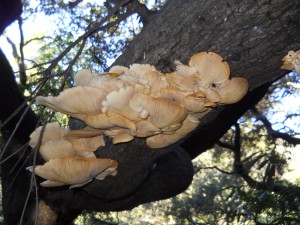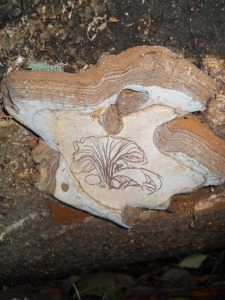The rains have finally begun here in the east SF bay area, and you know what all they promise?…. Mushrooms!!! That’s right, from the toxic to tasty, they’re a-springing up everywhere in the dank woods.
Now being from a highly fungophobic culture, no one has ever personally showed me what wild mushrooms are good to eat. Although Chris Hobbs once ID’d some pics I’d taken of a Boletus sp. for me back when we were co-gsi’s for intro bio:

Boletus rubripes – bitter bolete

Boletus rubripes – bitter bolete
But with All That the Rain Promises and More, plus Mushrooms Demystified by David Arora, perhaps the best field guides ever written on any subjects, I’ve finally gone and collected huge bunches of wild edible oyster mushrooms, and feasted on their tasty flesh!
I was also able to identify some toxic and artistic mushrooms on the same foray!
I love eating mushrooms, and a local market (Monterey Market) sells wild-picked chanterelles, oyster mushrooms, and more, but they cost about an arm a dozen. I splurged a few times, mainly to familiarize myself with these species in hopes of encountering them in the wild.
I also have spent over a year absorbing what I’ve read in the above books by Arora (1986, 1991). All That the Rain Promises and more is pocket-sized and covers mainly bay area and California species, while Mushrooms Demystified covers most of North American mushrooms, excepting mostly southeastern species. Both are also laced with hilarious anectdotes, witticisms, and clever turns of phrase; the author really puts the fun in fungi (see, I stole that from him)!
And no, this doesn’t hinge on magical mushrooms… which are still fully described and appreciated by the book, though he doesn’t have much appreciation of those who only care about such types of mushrooms.
So about my foray yesterday….
I first gathered my ‘shroomin outfit: wet-weather boots and jacket, knife (for digging out mushroom bases for ID and for scraping them clean with the back of the blade), camera and field notebook for recording field observations, collecting bag with a stiff sheet of cardboard to prevent the mushrooms from being crushed, waxpaper and aluminum foil for wrapping my collected specimens (don’t use paper or plastic bags due to moisture issues he says), and don’t forget a cheese sandwich (since I’m always hungry like the author apparently is, who has a little bit more than a fondness for these).
I set out, with a gleam in my eye and spring in my step, but not yet a song in my heart…
At first, I was a little disappointed the woods weren’t exactly burgeoning with mushrooms… but maybe I was a little early. It has been super dry here; I don’t think it’s rained all fall. But the last two days it had dumped and poured and finally just sprinkled the night before last, when I decided it was time to gather.
The first mushrooms I found were small and bright yellow, growing on a dead (unidentifiable, severely decomposed) log in a little ditch leading toward and just near Strawberry Creek. I was pretty excited. I collected some and took pictures. Just next to it, also on a dead log, was an artist’s conk.

Sulfur tufts (Hypholoma fasciculare) growing on a rotten log

Sulfur tufts (Hypholoma fasciculare) growing on a rotten log

Sulfer tufts (Hypholoma fasciculare) growing on a rotten log
My intuition told me the little yellow guys were toxic, but anyway there weren’t really enough to eat. But I collected a few to take home and ID. It turned out my intuition was correct (bright colors usually equal toxic); these guys were Hypholoma fasciculare (Naematoloma fasciculare is a synonym), common name sulfer tufts, aka the clustered woodlover, which are poisonous.
The sulfer tufts can be used to make dye though; I’ll try this sometime since they’re so abundant and vibrantly colored.
I wandered around more and soon got occupied collecting California Bay Laurel nuts, which were just overflowing in this one spot under a grand tree (see my post below about this tree species and eating their nuts, and their many other uses).
I kept wandering around, examining dead logs, and under trees looking for “mushrumps” or what Arora (1991) calls humps of leaf litter indicating a newly popping out mushroom. Not much luck.
I found some toyon (Heteromeles arbutifolia) berries, which I gladly gathered.
Then, while stopping to… ahem “water a tree,” there they were: two huge clumps of oyster mushrooms!

Oyster mushrooms (Pleurotus ostreatus) growing on dead coast live oak (Quercus agrifolia) log

Something like eep-yaaah!! came out along with a little skip-hop. I knew exactly what they were the second I saw those! But my fungophobic heritage made me double-check my field guide right on the spot and later back home I also consulted Mushroms Demystified and both these guides fit the description of what I found perfectly. The most similar appearing and toxic mushrooms to oyster mushrooms were the jack-o-lantern and Clitocybe. So I checked these descriptions and made sure it wasn’t those.
After finding this first two clumps (I only collected the fresher one, leaving the second,larger clump for animals), I kept wandering around, hoping for a feast.
And persistance paid off, because soon enough, I found another huge clump of oysters!

Oyster mushrooms (Pleurotus ostreatus) growing on standing dead branch of coast live oak (Quercus agrifolia)

Oyster mushrooms (Pleurotus ostreatus) growing on standing dead branch of coast live oak (Quercus agrifolia)
I gathered less than half of these, just the fresher ones from which I still had to shoo off some pleasing fungus beetles (actually their common family name), and one big black beetle, (which was not so pleasant-looking), leaving most behind for the animals, or perhaps a more cavalier mushroom hunter than me. Before and after gathering all these mushrooms, I made sure to say a short prayer of thanks to the oyster mushroom, oak tree, and forest spirits, something like: Yes! Thank you mushroom! Thanks Oak! Thanks Forest!
I immediately found another huge clump, but it was under a log and behind some shrubs and looked older (can you find it in the below photo?), so I just left it, feeling satisfied with my haul.

Oyster mushrooms (Pleurotus ostreatus) growing under dead log of coast live oak (Quercus agrifolia)
Oh yeah. Now I had that song in my heart. Inspiration struck! I began my ditty: “(high voice) how big is your fungus, say is it humongous? (low voice) Yes my fungus is humongous; there’s enough to share among us!” Some vivacious, Mozart-esque whistling was the refrain. Kept that going with an even springier step and gleamier eye til I cavorted out of the forest, my mushroom bag heavy with delight!
Along the way I found some more artist’s conks, and left a little drawing of the oyster mushrooms on a well-displayed one.

Artist’s conk (Ganoderma applanatum) on a CA bay laurel log with drawing of oyster mushrooms
Back home, I excitedly displayed the day’s (3 hours…) haul to Emily:

Wild plants and mushrooms gathered in a few hours: three large clumps of oyster mushrooms, sulfer tufts (poisonous), toyon berries, peppernuts, bay leaves (for flea repellant)
Fungophobic paranoia made me first cook up a few caps from each clump to eat a small amount with Emily to make sure we didn’t have some allergic reaction. We only waited an hour or so, then I decided to cook up all of one of my three large clumps.
I followed the recommendation of Arora (1991, 1986) to cook them. First I cut off the tough, short stalk part, then washed them, allowing them to drip dry a few minutes. Then I dry-pan-fried them on high, finally adding a little butter and olive oil at the end. A pinch of salt… and done!

dry pan frying oyster mushrooms

Dry pan fried oyster mushrooms with a pat of butter and dash of salt added at the end
One of the clumps seemed to taste a little better and more oystery than the other, which didn’t have all too much taste. But I liked the texture of them both. And the fact I just gathered these from the wild, applying my newfound knowledge made them taste soo much better!
Dinner was good that night.

I can’t wait to go mushroom gathering again!
Beyond being delicious, mushrooms are nutritious. Quoting from Anderson and Lake (2013):
“Today Central Sierra Me-Wuk elder Phyllis Montgomery says, “the willow [oyster] mushrooms [possibly Pleurotus cornucopiae (Paulet) Rolland formerly P. ostreatus] are like a steak —they’re chewy” (Anderson unpublished field notes 2010). Generally, protein concentrations in mushrooms range from 1 to 4% of fresh weight, or about 10–45% of dry weight, a significant amount (Hobbs 1995:54–55). For the amount of crude protein they provide, mushrooms rank below animal meats but well above most other foods, including milk (Chang 2008). Additionally, mushroom protein contains all of the nine essential amino acids required by the body (Cheung 2008). They are high in fats, phosphorus, copper, iron, various trace elements, and such vitamins as B, D, K, thiamine, riboflavin, ascorbic acid, ergosterol, and niacin (Arora 1986; Barros et al. 2008; Cheung 2008).”
Plus, now that I know where to find the oyster mushrooms I can keep going straight back to the same spot after the next rains, and year after year, since this species (species complex) tends to regrow from the same dead logs (Arora 1991). In fact, you can take home a log from which you collect oyster mushrooms and water it occasionally to make it grow more mushrooms (Arora 1991)!
The California Indians were of course well aware of this fact. Quoting again from Anderson and Lake (2013):
“Many kinds of mushrooms, such as sorog (Neolentinus ponderosus (O.K. Mill.) Redhead & Ginns), appear in the same places year after year, arising from the surfaces of rotting wood, dead stumps, snags, or downed logs during the long process of decomposition. Other mushrooms arise from the ground and have long-term associations with trees, shrubs, and grasses (Douhan et al. 2005; Hynes et al. 2010; Plamboeck et al. 2007). Thus, many California Indians have special areas that they repeatedly visit (Anderson 2009; Richards and Creasy 1996). “These sites are hundreds of years old,” said N. Turner Behill, regarding mushroom gathering areas (Anderson unpublished field notes 2006). Tom Carsoner, Central Sierra Me-Wuk, described his mushroom gathering sites as “a garden” because “you always know where to go” (Anderson unpublished field notes 2010).”
Anderson, M. K. and Lake, F. K. 2013. California Indian ethnomycology and associated forest management. Journal of Ethnobiology 33(1): 33-85.
Arora, D. 1986. Mushrooms demystified. Ten Speed Press, Berkeley, CA.
Arora, D. 1991. All that the rain promises and more… : a hip pocket guide to western mushrooms. Ten Speed Press, Berkeley CA.
Disclaimer: Always be certain of the identity of any mushroom or plant before ingesting. Many mushrooms and plants superficially look very similar, and without expert identification, it is easy to mistake a poisonous and edible species. I assume no responsibility for any harm, injury, or death from information given in this post.


















